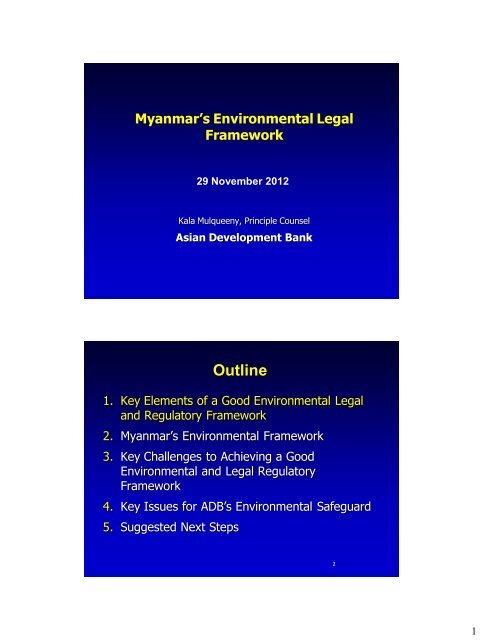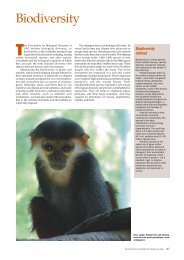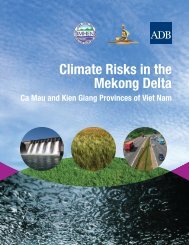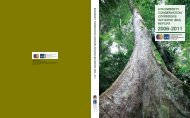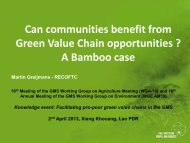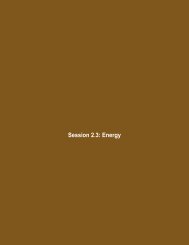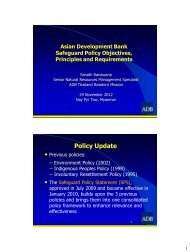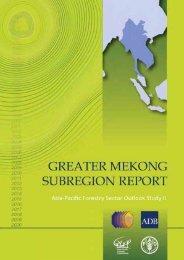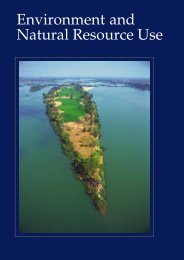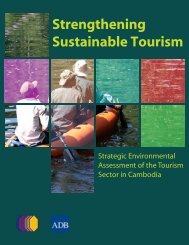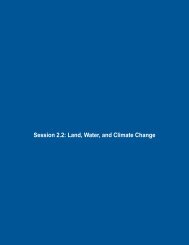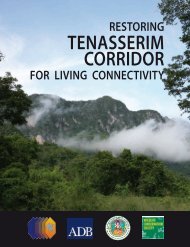Myanmar's Environmental Legal Framework - GMS-EOC
Myanmar's Environmental Legal Framework - GMS-EOC
Myanmar's Environmental Legal Framework - GMS-EOC
You also want an ePaper? Increase the reach of your titles
YUMPU automatically turns print PDFs into web optimized ePapers that Google loves.
<strong>Legal</strong> and Regulatory <strong>Framework</strong> forComprehensive <strong>Environmental</strong> Management3Comprehensive Environment and NaturalResources <strong>Legal</strong> and Regulatory <strong>Framework</strong>:Core <strong>Environmental</strong> and Planning Laws• Planning and Zoning• <strong>Environmental</strong> Assessment• Air Quality and Pollution• Water Quality and Pollution• Solid Waste• Hazardous and Toxic Waste• Land and Land use42
Comprehensive <strong>Legal</strong> and Regulatory<strong>Framework</strong>: Natural Resources• Renewable Biodiversity• Forest Resources and Forests• Marine Resources and Fisheries• Wildlife and Endangered Species• Non-Renewable• Mining - mine tailings dams• Oil & Gas - spills5Institutional• Clarity of Institutional Mandates and Governmental /Agency Roles and Responsibilities• Agencies autonomy and Power to Regulate and EnforceLaw• Clearly establish a standard of conduct• Clearly address how compliance is to be measured• Require Targets to Self-Monitor• Offenses and Penalties sufficient deterrent• Public right to environmental information and bring suit(assists enforcement)63
Outline1. Key Elements of a Good <strong>Environmental</strong> <strong>Legal</strong>and Regulatory <strong>Framework</strong>2. Myanmar’s <strong>Environmental</strong> <strong>Framework</strong>3. Key Challenges to Achieving a Good<strong>Environmental</strong> Regulatory <strong>Framework</strong>4. Key Issues for ADB’s <strong>Environmental</strong> Safeguard5. Suggested Next Steps7International <strong>Environmental</strong> Law:Air and Atmosphere• Vienna Convention for the Protection of the OzoneLayer• Montreal Protocol on Substances that Deplete theOzone Layer• London Amendment to the Montreal Protocol onSubstances that Deplete the Ozone Layer• Copenhagen Amendment to Montreal Protocol onSubstances that deplete the Ozone Layer• United Nations <strong>Framework</strong> Convention on ClimateChange (UNFCCC) and Kyoto Protocol• ASEAN Agreement on Transboundary Haze84
International <strong>Environmental</strong> Law:Hazardous Waste and Toxic Substances• Stockholm Convention on Persistent OrganicPollutantsLand• United Nations Convention to CombatDesertification9International <strong>Environmental</strong> Law:Biodiversity, Forests, and Cultural Heritage• Convention Concerning the Protection of the WorldCultural and Natural Heritage• Convention on Biological Diversity• Cartegena Protocol on Biosafety• International Tropical Timber Agreement• Ramsar Convention on Wetlands• Convention on International Trade in EndangeredSpecies of Wild Fauna and Flora (CITES)• ASEAN Agreement on the Conservation of Natureand Natural Resources105
National <strong>Framework</strong>: 2008 Constitution• Government “shall protect and conserve the naturalenvironment” Chapter 1, Section 45• National legislature can enact environmental andprotection and natural resource laws but need not.Chapter 4, Section 96.• State and Division Legislatures - power toregulate environmental protection, within boundariesof national legislation. Chapter 4, Section 196• Citizens have the duty to “assist” government inenvironmental conservation. Chapter 8, Section 390.• BUT, no constitutional rights to a clean andhealthy environment e.g. the Philippines.111994 National <strong>Environmental</strong> Policy• Objective – “integration of environmental considerationsinto the development process to enhance the quality oflife of all its citizens.”• State’s sovereign right to use its natural resources inaccord with its environmental policies: but great care notto exceed its jurisdiction or infringe upon the interests ofother nations.• State responsibility to preserve its natural resources in theinterest of present and future generations.• <strong>Environmental</strong> protection should always be the primaryobjective in seeking development1999 Myanmar Agenda 21126
Environment<strong>Framework</strong> Legislation• The Environment Conservation Law (2012)Water• The Underground Water Act (1930)• The Water Power Act (1927)• The Yangon Water-works Act (1885)Land• Farmland Law (2012)• Vacant, Fallow, Virgin Lands Management Law (2012)• The Pesticide Law (1990)13EnvironmentUrban Environment and Development Planning• Limited authority over local water supply andeffluent, solid waste• The City of Yangon Development 1990, asamended• The Development Committees Law• The Mandalay City Development Law• The City of Yangoon Municipal Act147
Natural ResourcesMining – reference to environmental conservation• Mines Law (1994) / Gemstone Law (1995)• Pearl Law (1995) / Salt Enterprise (1992)Fisheries – permitting scheme• The Myanmar Marine Fisheries Law (1990 and 1993)• The Law Relating to the Fishing Rights of ForeignFishing (1993)• Freshwater Fisheries Law (1992)• Law Relating to Aquaculture (1989)15Natural ResourcesBiodiversity – protected species and protected areas• The Protection of Wild Life and Wild Plants and Conservation(1994) – 2012 AmendmentsCultural Heritage – sites and monuments• The Protection and Preservation of Cultural Heritage (1998)Forestry – fairly complete – expect 2012 Law stronger communityrecognition• The Forest Law (1992)• Forest Policy (1995)• Forest Rules (1995)• Myanmar Agenda 21 (1997)• Community Forestry Instruction (1995)• National Forestry action plan (1995)• National code of practice for forest harvesting168
1. Key Features:Environment Conservation Law (2012)• Establishes <strong>Environmental</strong> ConservationCommittee• Confers powers on Ministry to regulate• Empowers Ministry to establish a “priorpermission scheme”• Requires Ministry to have acomprehensive waste and pollutantmonitoring scheme• Two clear obligations171. Key Features: EnvironmentConservation Law (2012) cont.• Requires Ministry to cooperate and givetechnical advice on• environmental conservation to departmentsmanaging Natural Resources; and• urban environment to relevant departments• Requires Committee and Ministry to take“necessary measures relating to anenvironmental emergency.”• Establishes Offences• Allows Ministry to allow Exemptions toGovernment or Business189
The Environment Conservation Law (2012) –Confers Powers to establish <strong>Environmental</strong><strong>Framework</strong>• Article 7 – Confers Powers and Functions on the Ministry• Sets environmental quality standards• Specifies classes of hazardous waste and substances• Prescribe wastewater treatment regulations• Prescribe emission standards• Formulates EIA and SIA system• Sets guidelines for protecting the ozone layer,biodiversity and coastal conservation, climate change,desertification, persistent organic pollutants• Ensuring the polluter pays• Issue rules, regulations and by-laws as may be necessary19with the approval of the Union GovernmentOutline1. Key Elements of a Good <strong>Environmental</strong> <strong>Legal</strong>and Regulatory <strong>Framework</strong>2. Myanmar’s <strong>Environmental</strong> <strong>Framework</strong>3. Key Challenges to Establishing andImplementing a Good <strong>Environmental</strong>Regulatory <strong>Framework</strong>4. Key Issues for ADB’s <strong>Environmental</strong> Safeguard5. Suggested Next Steps2010
1. The Environment Conservation Law (2012),<strong>Environmental</strong> Assessment: No EA• <strong>Environmental</strong> and Social Impact Assessment - Article 7– Ministry has the power to establish a system• Prior Permitting - Article 22 – 25 allows the Ministry toestablish a permitting scheme for businesses that may causesignificant environmental harm and require prior permission, byprescribing categories of business etc., that requires a permitwith conditions• Benefit – could be used for EIA• Risk – the permitting scheme is discretionary, and there is nobasis in the law for the Ministry to determine whether or not toissue a permit, and whether to impose environmentalcompliance conditions on the user.• Challenge – to heed Agenda 21’s call and establish aneffective EA system as soon as possible.21Myanmar’s Agenda 21 (1999) :<strong>Environmental</strong> Impact Assessment“The development of a system and framework forenvironmental impact assessments in Myanmar is a vitalmeans of integrating environment and development.” para.18.1.7.“EIA is a vital and useful tool for planning and decisionmaking..…..”para. 18.1.6.“…(EIA) systems and procedures should be adopted assoon as possible. “ para. 18.1.32211
2. Air & Water Quality & Pollution andSolid Waste: Target Obligations in EC Law• Article 14 – “Any person causing a point source ofpollution shall treat, emit, discharge, or deposit anypollutants which cause environmental pollution, inaccord with stipulated environmental qualitystandards.”• Pollution – any direct or indirect alteration or effect…on any part of the environment…including land, water,or air by discharging, emitting or depositingenvironmental hazardous substances, pollutants, orwastes…. Etc… [Broad]• Pollutant – any liquid, solid, or gas... which …alters thequality … of the environment or is hazardous orpotentially hazardous… [Broad]23Air & Water Quality & Pollution andSolid Waste: <strong>Environmental</strong> Quality Stds in Law• Article 10 – Ministry may stipulate environmentalquality standards with the approval of thegovernment and the Committee• Water quality and wastewater standards• Air quality and emissions• Noise pollution standards• Solid waste standards• Other that the government stipulates• Key Challenge / Question – Article 7 givesMinistry power, but Article 10 requires the approvalof the government and the Committee – unclear24power and approvals.12
Air & Water Quality &Pollution andSolid Waste:EC Law• Benefits - Operable provisions; broad definition ofpollutant includes solid and hazardous waste• Challenges –• Ministry needs to stipulate environmental qualitystandards and get approval of Union Government andCommittee (Article 7)• Ministry needs to cover non-point sources eventually;• Not clear emission or discharge limits,• Will be hard to measure point source contribution todecline in environmental quality• Seeks to be an environmental quality standard not ameasurable emissions standard25Air & Water Quality &Pollution andSolid Waste:Owner/Occupier Obligation• “Article 15 – “The owner or occupant of a point source ofpollution which is an activity, material or place shall install oruse an on-site facility or controlling equipment in order tomonitor, control, manage, reduce or eliminate environmentalpollution. If this is not possible, it shall be arranged to disposethe wastes in accord with environmentally sound methods.”• Benefits - Operable provisions; clear need to do somethingabout the pollution.• Challenges –• Not clear what standard the owner operator is being held to(i.e. “reduce or eliminate environmental pollution”)• No definition of “not possible” – who decides the operatoror the government• No definition of “environmentally sound methods” – what26counts.13
The Environment Conservation Law (2012):Monitoring• Article 13 – Ministry shall, with the Guidance of the Committee,have a comprehensive monitoring system and monitor:• Agro-chemicals• Pollutants and disposal of hazardouns substances• Waste disposal from metals, minerals, and gems• Waste disposal and sanitation• Development and building works• Key Challenges - No obligation for “agro-chemicals” despitea pesticide law, limited capacity, limited systems, coordinationamongst different departments, no reference to obligations27The Environment Conservation Law (2012):Urban Environment• Article 17 – Ministry advise government departments,government organizations, private organizations, andindividuals, in accordance with guidelines laid down by thecommittee:• Land use plans and management• Management of the construction industry• Management of human housing settlements• Waste management• Pollution control• Key Challenge / Question – Coordination with DevelopmentCommittess.2814
The Environment Conservation Law (2012):Natural Resources• Article 18 – Relevant Government departments andGovernment organizations shall carry out the conservation,management, beneficial use, sustainable use etc., of naturalresources.• Ministry shall cooperate with the relevant Governmentdepartments and Government organizations for the longlasting of cultural heritage heritage areas, natural heritageareas, cultural monuments, and natural areas.• Ministry to provide necessary technical support.• Benefit – Seeks integration with sectoral policies andcoordination amongst Ministries and departments• Risks and Challenges – environmental and natural resourcelaws are not streamlined and natural resource laws are notfocused on sustainability ; coordination will be very difficultbecause current natural resources laws don’t coversustainability29The Environment Conservation Law (2012):Offences and Penalties• Key for Offences is deterrent effect.• Are these large enough?• Article 31 – Operates a business etc without a prior permissionwhen needed 100,000 kyats• Article 32 – offence to violate subsidiary instruments madeunder the law and up to 1 years jail and a fine• Article 33 – imports, exports, produces, stores, transports, ortrades prohibited material 3-5 years imprisonment, and finefrom 100,000 -2,000,000 kyats. Bears the cost of making goodthe environment.3015
Myanmar Agenda 21: Preparation of<strong>Framework</strong> Legislation• 18.2.17 framework legislation to embody the basic principles ofsustainable development from the Rio Declaration,• Polluter pays principle• Precautionary principle• Transparency and public participation (and justice) “Access”• Multi-sectoral and mult-disciplinary approach to issues ofenvironment and development• Intra and inter-generational equity31• Capacity• Coordination• PrioritizationKey Challenges• Developing and approving coreenvironmental legislation• Streamlining and integrating related sectoraland natural resources legislation• Monitoring and establishing a monitoringsystem3216
Outline1. Key Elements of a Good <strong>Environmental</strong> <strong>Legal</strong>and Regulatory <strong>Framework</strong>2. Myanmar’s <strong>Environmental</strong> <strong>Framework</strong>3. Key Challenges to Establishing andImplementing a Good <strong>Environmental</strong>Regulatory <strong>Framework</strong>4. Key Issues for ADB’s <strong>Environmental</strong> Safeguard5. Suggested Next Steps33<strong>Environmental</strong> Assessment• No system of environmental assessment, none ofADB’s environmental assessment principles aresatisfied here.3417
Biodiversity Protection andSustainable Natural Resource Management• Currently no adequate safeguard in nationallegislation that prevents projects• significantly converting or degrading naturalhabitats, except if mitigated, the benefitsoutweigh the costs and there are noalternatives.• Having measurable adverse impacts on criticalhabitat which could impair its high biodiversityvalue or ability to function, lead to reductionsin the populations of recognized endangered orcritically endangered species• Ensures additional conservation measures aretaken for projects in protected areas.35Pollution Prevention and Abatement• Currently no adequate safeguards ensuring• the application of pollution prevention and controltechnologies/practices consistent with internationalgood practices such as the WB Group’s EHSguidelines• avoid pollution, or where not possible, minimize orcontrol the intensity or load of pollutant emissionsand discharges, including direct and indirect GHGs,waste generation and release of hazardousmaterials• The purchase use and manage pesticides based onintegrated pest management approaches andreduce reliance on synthetic pesticides3618
Occupational Health and Safety• no employee health and safety related laws satisfyingthis safeguard.• No emergency planning satisfying this safeguard.37Physical Cultural Resources (PHCR) Protection• Protection of Cultural Heritage Law relates only toAncient Monuments and Ancient Sites3819
Outline1. Key Elements of a Good <strong>Environmental</strong> <strong>Legal</strong>and Regulatory <strong>Framework</strong>2. Myanmar’s <strong>Environmental</strong> <strong>Framework</strong>3. Key Challenges to Establishing andImplementing a Good <strong>Environmental</strong>Regulatory <strong>Framework</strong>4. Key Issues for ADB’s <strong>Environmental</strong> Safeguard5. Suggested Next Steps39Suggested Next Steps• <strong>Environmental</strong> Assessment Regulation, satisfyingMDB requirements and including core features ofEIA• Regulation specifying strict conditions for exemption• Regulation on Air Quality and Pollution• Regulation on Water Quality and Water Pollution,including waste-water treatment• Regulation for Solid Waste• Regulation for Hazardous Waste4020


